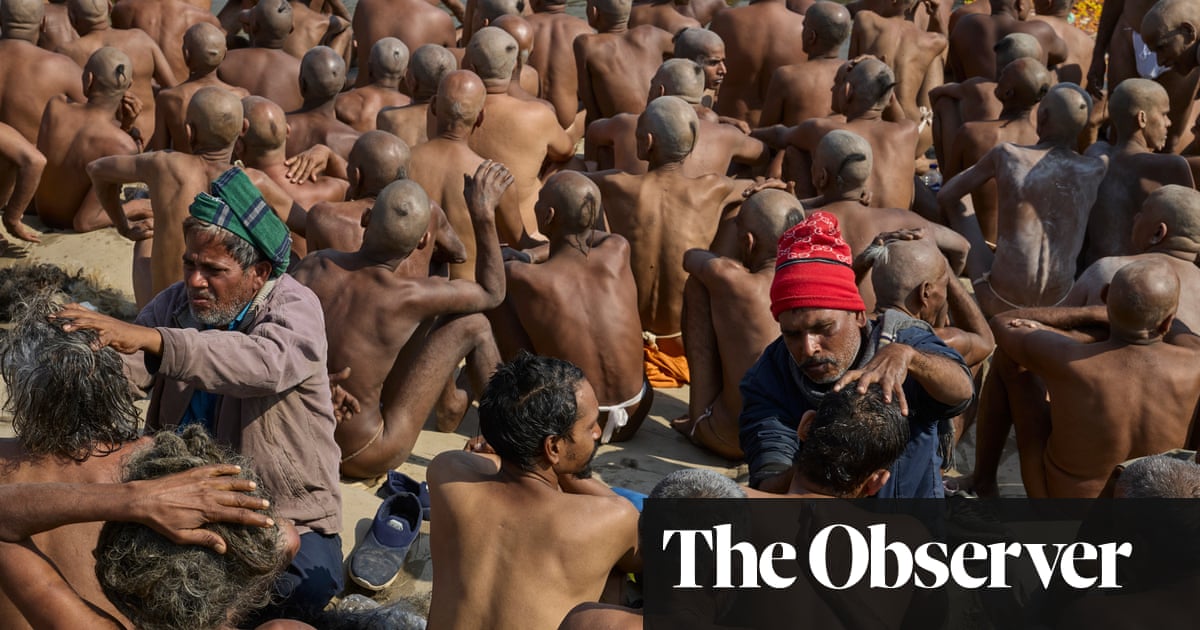They sat quietly together on the banks of the Ganges river, heads bowed in sombre meditation. Some men were naked, their bodies smeared grey with ash. Others had a simple saffron cloth tied around their waist. Nearby, barbers balanced on their haunches, shaving the head of each man clean with a flick of their knives, save for a small strand at the back.
This ceremony, in which millions of pilgrims seek to cleanse their sins to break the cycle of reincarnation has been taking place at the Kumbh Mela festival for centuries. It is mandatory for thousands of sadhus – Hindu holy men who live an austere life of strict spiritual discipline. Among the most sacred events in the Hindu calendar, the festival occurs every 12 years across four sacred locations in India where it is believed the Hindu god Vishnu once spilled drops of the nectar of immortality.
This year, the scale and political prominence of the festival, held in the north Indian city of Prayagraj, is set to exceed previous records. According to the government’s own estimates, it is expected that more than 400 million devotees will attend the festival by the time it ends, in late February, making it the largest gathering of humanity on earth.
For the akharas, the 13 ancient Hindu sects into which all the sadhus are initiated, this year’s Kumbh Mela has been particularly significant, marking a shift in their own cultural and political prominence in India.
The akharas, monastic orders that date back as far as the sixth century, each follow different gods. Earlier, they were training grounds for warrior-ascetics who would defend the Hindu holy sites and traditions, and today they are revered as essential custodians of ancient Hindu traditions and rituals. An estimated five million sadhus form the akharas.
This year, according to Mahant Ravindra Puri, president of the governing body for the akharas, “the number of sadhus which have been initiated in this Kumbh is manifolds higher than in previous ones”. He said the number exceeded 10,000.
High priests from several orders, some which boast upwards of half a million sadhus, said they too had recently witnessed a swelling in the ranks of those committing to the disciplined life of a Hindu ascetic, despite it being seemingly at odds with India’s rapidly modernising society.
“I would say it’s the beginning of a new era,” said Swami Shiv Premanand, a senior priest in the 8th-century Mahanirvani Akhara. “There has been an awakening, particularly among the youth, to Sanatana Dharma [the principles of Hinduism], and we see more are committing to become sadhus than ever before.”
In a view echoed by several of the akhara high priests, Premanand credited the rising prominence of the akharas with the Hindu nationalist government of prime minister Narendra Modi and his Bharatiya Janata Party (BJP). Modi’s 10 years in power have been marked by a concerted ideological push to move India away from its secular foundations and towards the establishment of the country as a fully fledged Hindu Rashtra or Hindu state.
Under this Hindutva project, there has been a merging of state with religion, while the prime minister has often positioned himself as a high priest figure preaching the virtues Sanatana Dharma, a term referring to a more traditional form of Hinduism. Yogi Adityanath, the BJP chief minister of the state of Uttar Pradesh where this year’s Kumbh Mela is held, is himself a hardline Hindu monk who is only ever seen in his religious saffron robes.
“We cannot deny the extraordinary role that the government has played in this awakening across the country,” said Premanand. “Modi and Yogi are completely devoted to the Sanatana Dharma. They work for us, so naturally we work for them.”
This year’s Kumbh Mela became as much as a political as a religious event, serving as a symbol of Hindu might in India for the BJP. The government spent a record 70bn rupees (£640m) on putting on the festival, as well as launching a nationwide publicity campaign around it bearing the faces of Modi and Adityanath. Modi was among those who took a holy dip at the festival in the Triveni Sangam, the sacred confluence of the Ganges, the Yamuna and the Saraswati rivers, at the Kumbh Mela.
This PR campaign extended to the akharas. A press release sent out by the Uttar Pradesh government during the Kumbh Mela spoke reverentially of the akharas as “spiritual powerhouses” and spoke of their “enduring relevance in the spiritual life in India”.
The close relationship between the government and the akharas was apparent after tragedy struck this year’s Kumbh Mela in late January, when at least 30 people died and 90 were injured during a crowd crush as tens of millions tried to reach the banks of the sacred rivers to bathe. The akharas did not criticise the government for the death of devotees and disruption of their holiest bathing ritual but instead publicly praised Adityanath for his “dedication” to Hindu culture.
Sakshi Maharaj, a religious leader of the Shri Nirmal Panchayati Akhada sect, is among those now pushing for political representation for the heads of the akharas and said he was in discussion with other akhara heads to put forward a proposal to the government. He is a BJP member of parliament.
“No government in the past has recognised and respected akharas and sadhus like the Modi government,” said Maharaj. “A consensus is building among us that all akharas should have some formal political representation in parliament to put forward our issues. People tend to trust sadhus more than traditional politicians.”
Nonetheless, the akharas have a troubled past of working together and throughout history have turned on each other in bloody massacres at the festival as they compete for status. At a meeting of senior ahkara figures last year, an angry dispute broke out and several seers had to be separated.
There has been some effort to diversify the ranks of sadhus in the akharas, which have traditionally have been predominantly male, patriarchal environments that exclude lower castes, particularly Dalits who were once known as “untouchables”.
For the first time, 1,000 women are expected to be initiated as sadhus at this year’s Kumbh Mela. And in 2015, the Kinnar Akhara was created for transgender people. Despite initial resistance by the sadhu community, the Kinnar Akhara is allowed to take part in the holy bathing rituals. However, it was recently embroiled in a public spat within their own ranks over the decision to allow a female Bollywood actor to join.
Many who become sadhus are committed to priests at birth by their parents, but increasing numbers of graduates and elderly figures who had found their spiritual calling later in life being are being initiated at the Kumbh Mela. Some observers credited the growing sadhu numbers with the renewed reverence for Hindu religious practice in India, while others speculated that India’s high youth unemployment rates and lack of employment opportunity could also be driving young men towards the ascetic life.
The enduring popularity of the sadhus, often referred to as “babas”, was highly apparent at the festival, with many drawing crowds of tens of thousands of devotees in a single day. Pilgrims came in their droves to pay their respects, often with a deep prostrating bow and a fistful of cash – followed by a selfie. Some of the more popular babas distributed cards with QR codes for devotees to scan to receive further information and a link to their social media account. it was also a popular approach among sadhus tooOthers directed devotees to YouTube to find the answers to spiritual questions.
Among the celebrated sadhus was 25-year-old Khadashvari Baba, who has committed to standing upright for 12 years, having done three years so far. Wearing nothing but his dark sunglasses and smoking his chillum of hash, Khadashvari leaned on a perch to keep him always standing on a single foot, even as slept.
With his own sizeable social media following, Khadashvari was adamant sadhus should be committed to tradition but also “move with the times – we can not just stay completely in the past”. As was evident among many sadhus, his rejection of earthly goods did not extend to a mobile phone – though he lamented that his had just been stolen at the festival.
Crowds were often the largest for the naked, ash-smeared Naga sadhus, who follow a particularly stringent life of devotion, renunciation and meditation, including celibacy and sometimes martial arts training and are rarely seen in public.
Sitting beside smoking coals and smeared in ash, Gaurav Giri, 44, a Naga sadhu, said he had seen a shift in how people viewed his fellow holy men and the kind of crowd at the Kumbh Mela. Before committing to the life of being a Naga ascetic, Giri’s previous employment had included working for British Telecom in the London suburb of Brentford and he confessed to being a “huge fan” of Downton Abbey.
“There is a lot of unwanted crowd at the Kumbh who are disturbing our peace, always wanting to take picture for the social media reels,” said Giri.
“But the PR is also good. More young people are coming here interested in becoming sadhus or just to praise us – we cannot complain about that.”
Article by:Source: Hannah Ellis-Petersen and Aakash Hassan in Prayagraj












